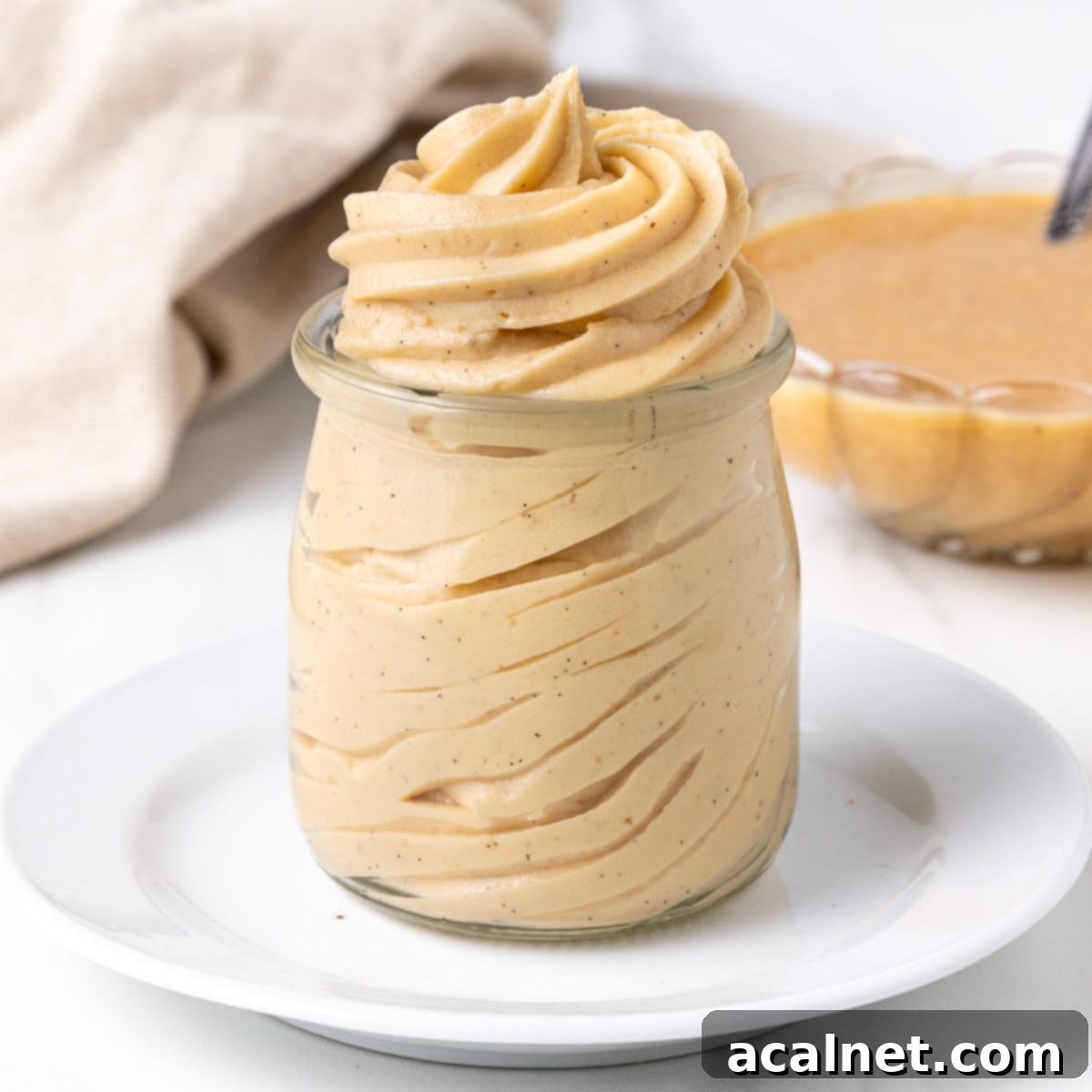Perfect Praline Mousseline Cream (Crème Mousseline au Praliné): The Ultimate French Pastry Filling
Prepare to be enchanted by the exquisite Praline Mousseline Cream, known in French as Crème Mousseline au Praliné. This incredibly rich and decadent cream is a staple in classic French patisserie, offering a luxurious texture and an unforgettable nutty caramel flavor. It’s the perfect filling or frosting, transforming ordinary cakes and pastries into extraordinary culinary delights, most famously found in masterpieces like the iconic Paris-Brest or the elegant Success Cake (Gâteau Succès).
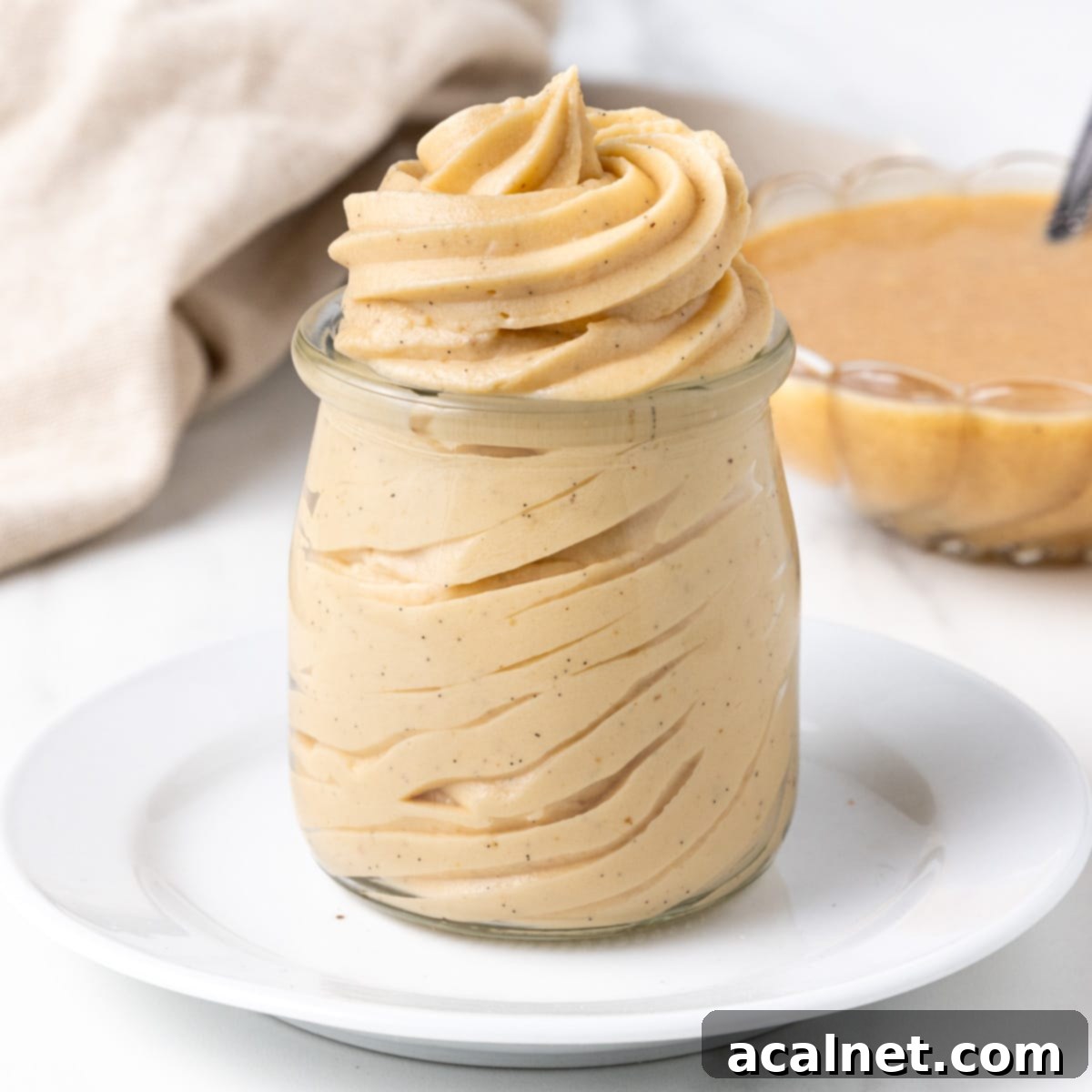
This Praline Cream is more than just a filling; it’s an experience. The irresistible praline paste, a blend of caramelized nuts, infuses the rich and fluffy mousseline cream with a deliciously deep, nutty flavor. Its versatility makes it suitable for filling a wide array of your favorite pastries, including delicate choux, elegant tarts, and elaborate layer cakes. While traditionally reserved for French classics like the Paris-Brest and Success Cake, its indulgent taste and pipeable texture mean you can use it in countless creative ways.
Key Ingredients for Praline Mousseline Cream
Crafting the perfect Praline Mousseline Cream begins with understanding the role of each ingredient. Here’s a detailed look at what you’ll need to achieve this luscious French cream.
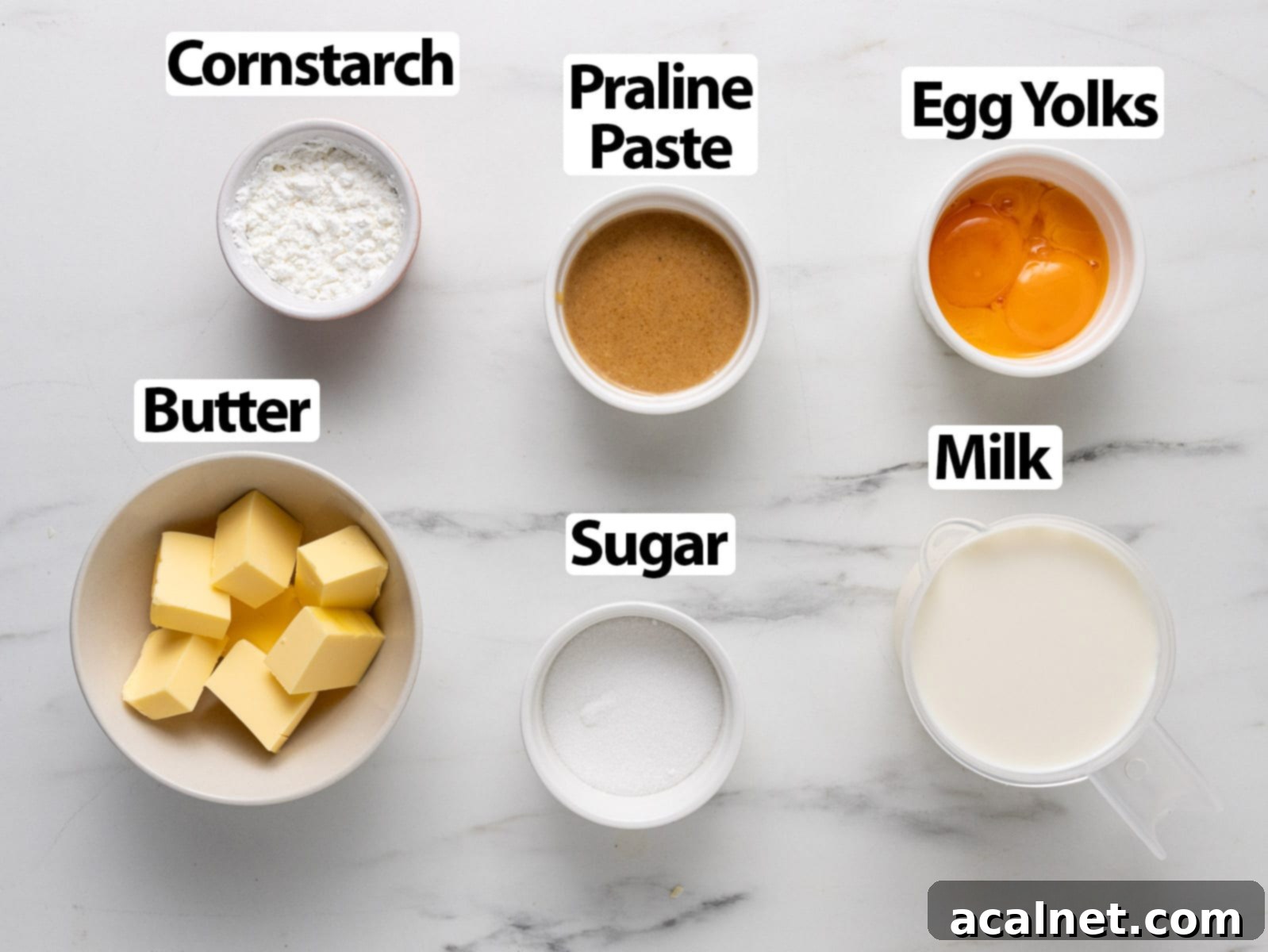
For precise quantities, please refer to the detailed recipe card below.
What goes into this delightful praline filling:
- Milk: For the most luxurious and rich result, always opt for full cream milk (whole milk). The higher fat content is crucial for the creaminess and body of your pastry cream. Avoid fat-free or skim milk, as they simply won’t yield the same decadent texture.
- Egg Yolks: These are the emulsifiers and thickeners of your cream. Using large egg yolks at room temperature is important for easy whisking and smooth incorporation into the mixture, preventing lumps and ensuring a silky finish.
- Sugar: Caster sugar, or fine white granulated sugar, is ideal. Its fine granules dissolve quickly, creating a smooth and sweet base for the pastry cream without any grittiness.
- Cornstarch: This is the primary thickening agent for the pastry cream component of the mousseline. Cornstarch yields a lighter, more delicate texture compared to plain or all-purpose flour. Always remember to sift the cornstarch before use to prevent lumps and ensure a perfectly smooth cream.
- Butter (in two parts): Butter is fundamental to mousseline cream, providing its signature richness and fluffy texture.
- First Part (50g): Incorporated into the hot pastry cream, this butter adds richness and gloss, and helps prevent a skin from forming as the cream cools.
- Second Part (150g): This larger portion is whipped separately until light and fluffy, then combined with the cooled pastry cream to create the airy mousseline texture. For both parts, a good quality, high-fat European-style butter (82% fat) is highly recommended for superior flavor and texture. The temperature of this butter is paramount—it must be soft and at room temperature (around 68-72°F or 20-22°C) to whip correctly and emulsify smoothly with the pastry cream, preventing splitting.
- Praline Paste: The star of this cream! Praline paste is a rich, aromatic blend of caramelized nuts (most commonly hazelnuts or almonds) that are roasted and then ground into a smooth, sometimes slightly crunchy, paste. You can purchase high-quality praline paste from specialty baking stores, or for an even fresher and customizable flavor, make your own praline at home. While hazelnut praline is used here, feel free to experiment with other nuts or even seeds for unique flavor variations.
Optional: Vanilla – Enhance the flavor profile with vanilla. You can add vanilla paste or vanilla extract directly to the milk, or for an even more intense aroma, infuse a fresh vanilla bean pod into the warm milk before straining it out.
How to Make Praline Crème Mousseline: A Step-by-Step Guide
Creating this magnificent cream involves two main stages: first, preparing a classic French pastry cream (crème pâtissière), and then transforming it into a light and airy mousseline with the addition of butter and praline paste. Precision in temperature and technique is key for a flawless result.
Part 1: Making the Pastry Cream (Crème Pâtissière)

- Heat the Milk: Begin by placing your full-cream milk in a medium-sized saucepan. Gently bring it to a simmer over medium-low heat. The goal is to heat it through without boiling, which could scorch the milk. If adding vanilla paste or extract, stir it in now. If using a vanilla bean, infuse it in the warm milk for 10-15 minutes, then remove it before proceeding.
- Prepare Egg Yolk Mixture: In a large, heatproof bowl, thoroughly whisk together the room temperature egg yolks and caster sugar until the mixture is smooth, pale, and slightly thickened. This process is called “blanching” and helps to prevent the yolks from curdling.
- Add Cornstarch: To the egg and sugar mixture, sift in the cornstarch. Whisk diligently until all lumps are gone and you have a smooth, homogeneous paste. Cornstarch ensures a smooth, stable cream.
- Temper the Eggs: This is a crucial step to prevent the eggs from scrambling. Slowly pour about one-third of the hot milk into the egg yolk mixture while continuously whisking. This gradually raises the temperature of the eggs without shocking them. Once incorporated, pour the entire tempered mixture back into the saucepan with the remaining hot milk. Whisk well until everything is completely smooth.
- Cook the Cream: Place the saucepan back over low heat. Cook the mixture for 5 to 8 minutes, stirring continuously and vigorously with a whisk. This constant agitation prevents sticking and ensures even cooking. You’ll know it’s ready when the cream visibly thickens and starts to produce large, puffing bubbles on the surface. Once these bubbles appear, continue whisking vigorously for another 30 seconds to a minute to ensure the starch is fully cooked and activated, then immediately remove it from the stove.
Ideally, use a kitchen thermometer to achieve perfect consistency. Crème pâtissière is fully cooked when it reaches a temperature of 82 to 84 degrees Celsius (180 to 183 degrees Fahrenheit).
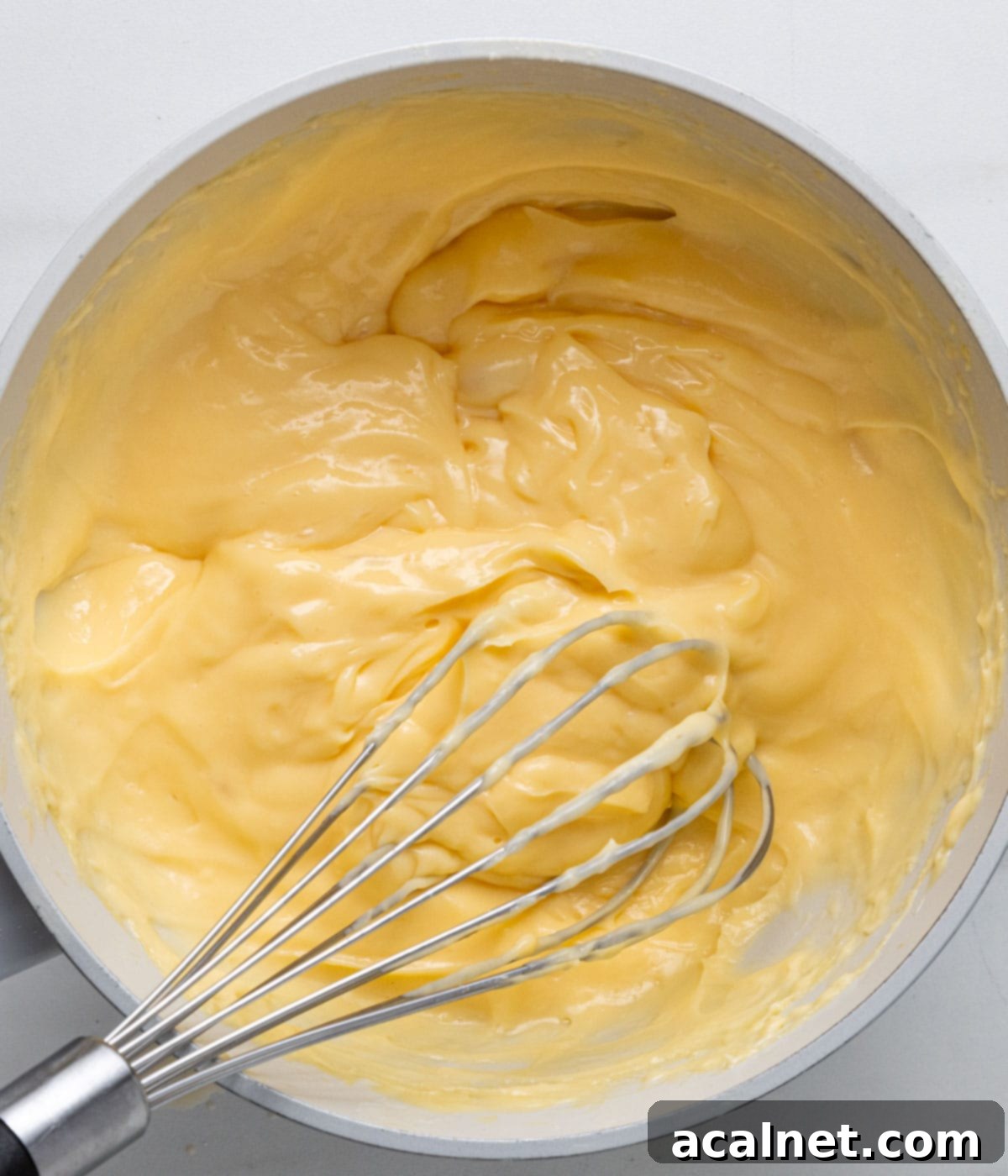
- Add First Portion of Butter: Off the heat, add the first portion of soft unsalted butter (50g) to the hot pastry cream, a little bit at a time. Whisk thoroughly until each addition is fully incorporated and the cream is smooth and glossy before adding more. This step enriches the cream and helps prevent a skin from forming.
- Chill the Pastry Cream: Immediately transfer the hot pastry cream into a wide, shallow dish (a baking sheet or a clean, wide bowl works well) to help it cool down quickly and evenly. Cover the surface of the cream directly with plastic wrap, ensuring no air is trapped between the cream and the wrap. This prevents a skin from forming and condensation from dripping back into the cream. Refrigerate for at least one hour, or up to 24 hours, until it is thoroughly chilled and firm.
Part 2: Incorporating the Butter and Praline Paste for Mousseline Texture
This stage transforms the chilled pastry cream into the light, airy, and stable mousseline.
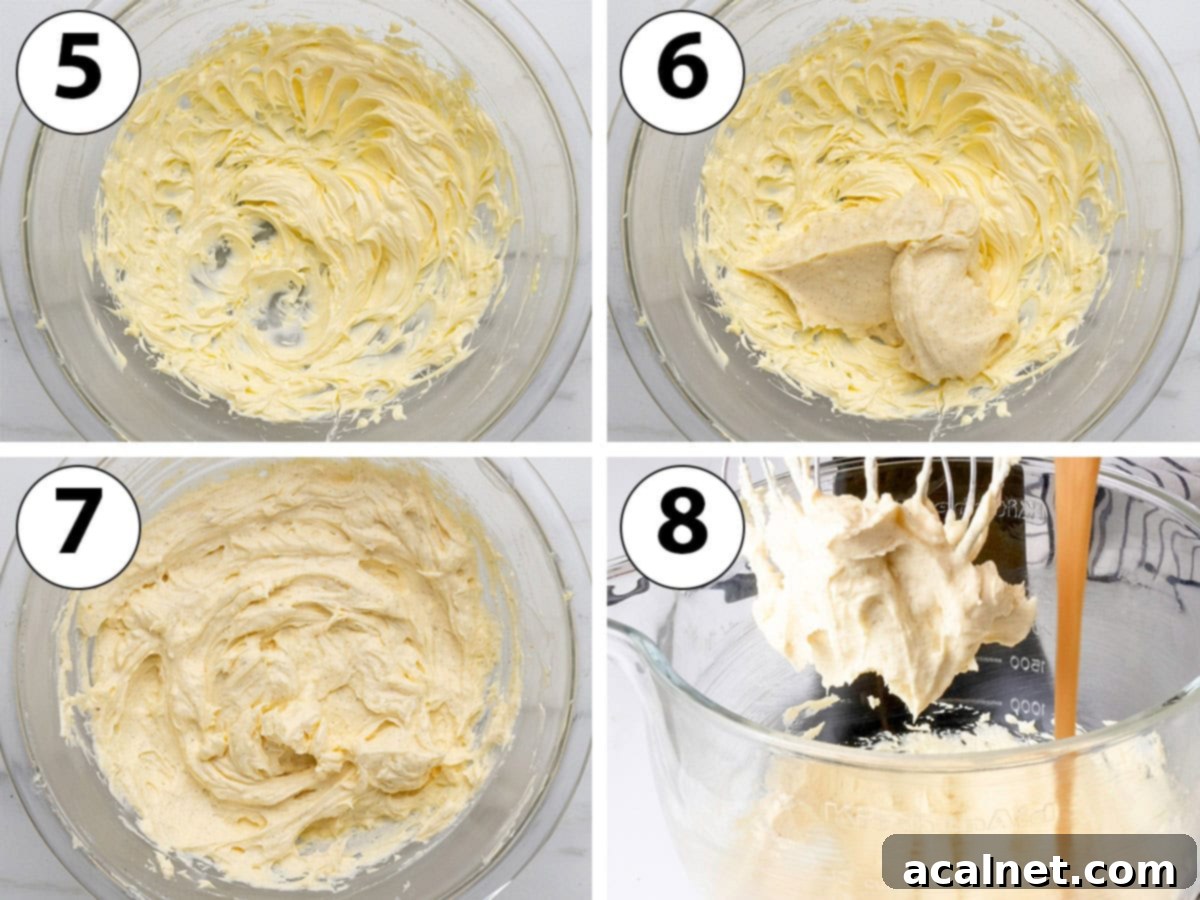
- Bring Pastry Cream to Room Temperature: This step is critical for a smooth mousseline. Take the chilled pastry cream out of the fridge at least 30 minutes, or even an hour if it was chilled for longer, to allow it to come back to room temperature (approximately 68-72°F or 20-22°C). It should be soft but still firm enough to hold its shape. Its temperature should ideally match that of your soft butter.
- Whip the Second Portion of Butter: Place the second portion of soft, room-temperature unsalted butter (150g) into the bowl of your stand mixer fitted with the whisk attachment. Whip on medium to medium-high speed for 2 to 3 minutes, or until the butter is noticeably light, fluffy, and slightly paler in color. This incorporates air, giving the mousseline its characteristic texture. The exact whipping time may vary depending on your butter’s temperature and your mixer’s power. Remember to stop and scrape down the sides of the bowl with a spatula periodically to ensure uniform whipping.
- Gradually Add Pastry Cream: With the mixer running on medium speed, begin adding the room-temperature pastry cream to the whipped butter, a little bit at a time (about a tablespoon at a time). It’s essential to allow each addition of pastry cream to be fully incorporated into the butter before adding the next. This slow process ensures a proper emulsion, creating a smooth and stable mousseline. Continue until all the pastry cream has been added.
- Incorporate Praline Paste: Once all the pastry cream is smoothly blended, add the praline paste to the mixture.
- Final Whip: Increase the mixer speed to high and whip for a couple more minutes. You’ll observe the cream transforming into a remarkably light, airy, and intensely flavorful praline mousseline.
Troubleshooting during this stage: If the cream appears too soft (glossy or greasy), this usually means it’s too warm. Simply place the bowl in the fridge for 10-15 minutes to allow the butter to firm up slightly, then continue whipping. If you notice small chunks of butter that aren’t mixing in (indicating the cream might be splitting or too cold), leave the bowl at room temperature for a bit longer to allow it to warm up slightly, then whip on high speed until smooth.
Note: There is an alternative method for incorporating the butter, as often shown in video tutorials. In this method, the pastry cream is whipped first until smooth, and then the soft butter is gradually incorporated. Both techniques will yield the same delicious result. For a more in-depth explanation of this method and other tips, you can explore my comprehensive Mousseline Cream post.

Recipe FAQs: Your Praline Mousseline Questions Answered
Praliné boasts a wonderfully deep, complex flavor profile that combines the sweetness of caramel with the rich, nutty notes of roasted nuts. The specific flavor can vary depending on the type of nuts used; for example, hazelnut praline offers a distinct toasted hazelnut aroma, while almond praline has a more delicate, sweet almond essence. This unique combination makes praline incredibly versatile and a favorite in many desserts.
Praline paste is traditionally created by blending caramelized sugar with roasted nuts until a thin, liquid, and often slightly crunchy paste is formed. Historically, it is made with either hazelnuts, almonds, or a balanced mix of both, which are the most common and classic choices. However, the beauty of praline is its adaptability; you can experiment with almost any type of nut, such as pecans or walnuts, or even some seeds like sesame, to create unique flavor variations tailored to your preference.
Understanding the nuances between these terms is key in French pastry:
Pralin: This refers to a thick, crunchy powder or coarse mixture, made by blending roasted nuts and hardened caramel. It’s the intermediate texture you achieve during the initial stages of processing praline paste. Pralin is commonly used as a delightful crunchy topping for desserts, providing both texture and flavor.
Praline (or chocolate praline): This term typically denotes a traditional Belgian chocolate bonbon. These exquisite chocolates are filled with a variety of luscious centers, such as smooth ganaches, rich creams, fruity fillings, decadent caramel, or indeed, praline paste itself! It’s important to note that French “Pralines” differ from American Pralines, which are a distinct confection usually made with pecans, sugar, cream, and butter, having a softer, fudge-like texture.
Praliné (or praline paste): This is the smooth, more or less liquid paste made from finely blending roasted nuts and caramelized sugar. It is the star ingredient in our Praline Mousseline Cream, providing deep nutty flavor and creamy texture.
Absolutely! While Praline Mousseline Cream is famously used in classic French pastries like Paris-Brest and Success Cake, its rich flavor and stable, pipeable texture make it incredibly versatile. It’s excellent as a filling for choux pastry (e.g., éclairs, cream puffs), a luscious component in tarts, a decadent frosting or filling for layer cakes and cupcakes, or even simply piped into individual dessert glasses for an elegant treat.

Expert Tips & Troubleshooting for Praline Mousseline Cream
Even experienced bakers can encounter challenges. Here are some common issues and how to resolve them for a perfectly smooth Praline Mousseline.
- The pastry cream is lumpy or grainy: This common issue often arises when the pastry cream is cooked at a temperature that is too high, causing the egg yolks to curdle and create lumps. To prevent this, ensure you are cooking the cream over a low heat and whisking continuously.
How to fix it: If your cream turns out lumpy, first try straining it through a fine-mesh sieve to remove larger bits. If a fine graininess remains, you can very gently blend it with an immersion blender for a few seconds. Be extremely careful not to over-blend, as excessive blending can break down the starch and butter, making the cream loose and liquidy. Prevention is key here: consistent low heat and constant whisking are your best friends. - The mousseline cream split or separated: A split mousseline cream typically occurs when there’s a significant temperature difference between the whipped butter and the pastry cream. If either component is too cold or too warm relative to the other, they will not emulsify properly, leading to a curdled or greasy appearance. I highly recommend using a kitchen thermometer to ensure both the butter and pastry cream are at the same room temperature (around 68-72°F or 20-22°C) before combining them.
How to fix it:
– If it’s too warm: The mousseline will appear flat, greasy, and possibly shiny. The butter has melted too much. To rectify this, place the entire mixing bowl containing the mousseline back into the fridge for 15-20 minutes. This allows the butter to firm up slightly. Once it has chilled, remove it and re-whip on medium-high speed until it becomes light and fluffy again.
– If it’s too cold: You will see distinct lumps or grains of butter that refuse to combine into the custard, giving it a curdled look. The butter is too solid. Leave the bowl at room temperature to allow it to warm up slightly. You can also carefully (and very gently, for just a few seconds) heat the outside of the bowl (if it’s heatproof) with a kitchen torch or over a very gentle warm water bath while constantly whisking. Once it has warmed slightly, whip on high speed until it comes together smoothly.
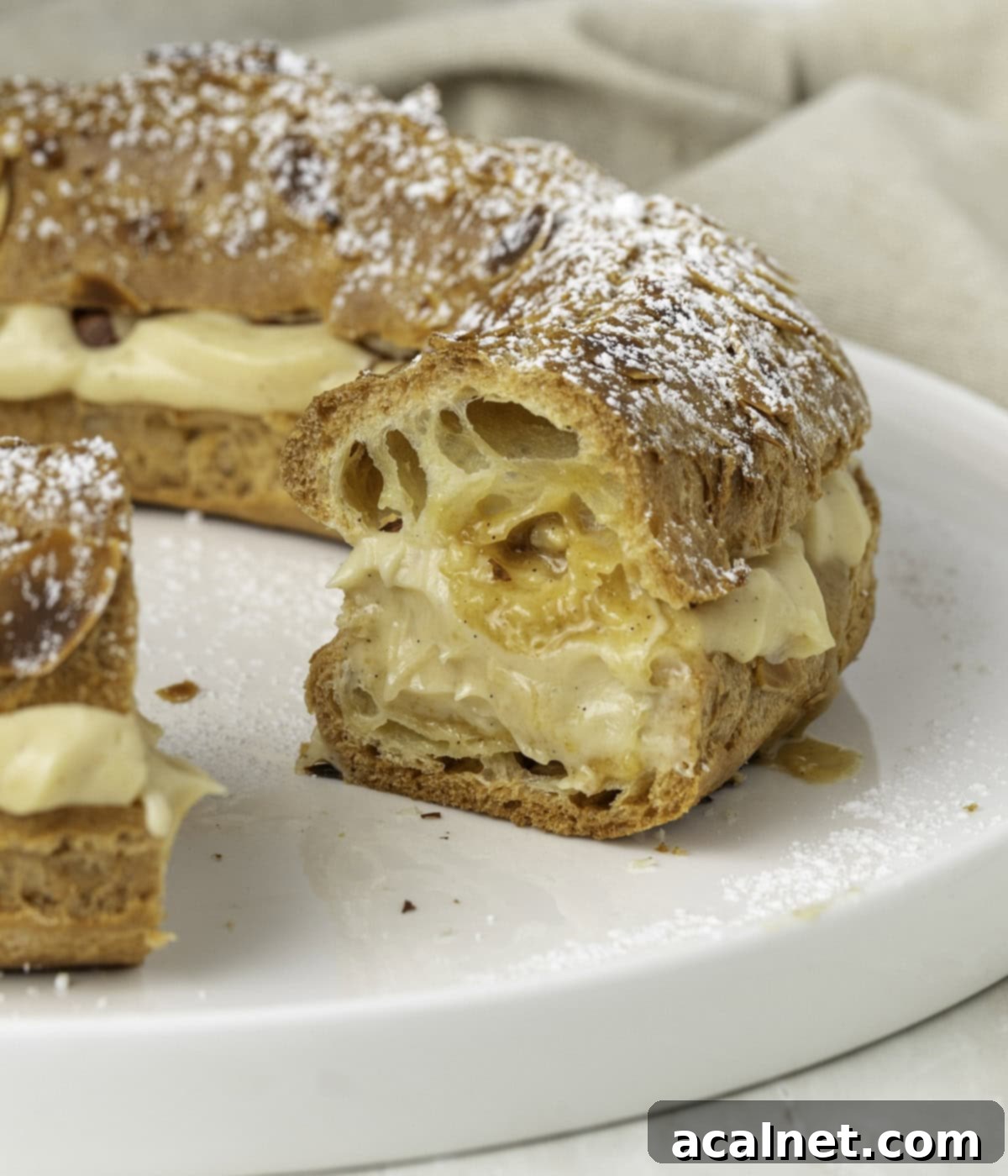
How to Use Praline Crème Mousseline in Your Desserts
The versatility of Praline Mousseline Cream extends to a myriad of dessert applications. Its stable yet airy texture and rich flavor make it an ideal choice for both classic and contemporary creations.
- For Entremets and Layer Cakes: This cream is exceptional for building multi-layered desserts. It is the traditional filling for a Success Cake (Gâteau Succès), beautifully complementing layers of delicate Dacquoise Sponge. It also works wonderfully in any elaborate entremet, adding a sophisticated nutty dimension.
- To Fill Choux Pastry Desserts: Praline Mousseline is most famously used to create the iconic Paris-Brest, a ring of choux pastry filled with this rich cream. Beyond Paris-Brest, you can use it to elevate other choux creations like classic Choux à la Crème (cream puffs) or crispy Choux au Craquelin. The contrast between the light choux and the dense, flavorful cream is truly delightful.
- To Make Tarts: Pipe this luscious cream into a pre-baked tart shell for an elegant and simple dessert. It can be topped with fresh fruit, chocolate shavings, or more praline for an extra touch of indulgence.
- As a Frosting / Filling for Cakes and Cupcakes: Its stable yet pipeable consistency makes it an excellent choice for frosting cakes or filling cupcakes, adding a gourmet touch that will impress any dessert lover.
- Individual Servings: Simply pipe it into small glasses or ramekins for a quick and elegant dessert, perhaps garnished with some chopped praline or a drizzle of caramel.
Storing & Freezing Your Praline Mousseline Cream
Proper storage is essential to maintain the quality and freshness of your Praline Mousseline Cream.
This cream should be stored in an airtight container or a mixing bowl covered with plastic wrap, ensuring the plastic wrap touches the surface of the cream to prevent a skin from forming and keep it fresh. When stored correctly, it will last for up to 3 days in the refrigerator. Any cakes or pastries filled with Praline Mousseline Cream also need to be kept refrigerated until you are ready to serve them. While it can withstand being at room temperature for a few hours during serving, especially if it’s not excessively hot, prolonged exposure to warmth will cause the butter to soften and the cream to lose its structure.
I do not recommend freezing this cream. The delicate emulsion of butter and pastry cream can break down during the freezing and thawing process, causing it to lose its signature fluffy texture and become grainy or watery.

Explore More French Creams
If you love the elegance and versatility of Praline Mousseline Cream, you’ll surely enjoy exploring other foundational French creams that are essential for any aspiring pastry chef or home baker.
- Bavarian Cream (Crème Bavaroise): A light, airy cream made with crème anglaise, gelatin, and whipped cream.
- Diplomat Cream (Crème Diplomate): A lighter version of pastry cream, created by folding whipped cream into crème pâtissière.
- Chocolate Crémeux: A rich, intensely chocolatey cream with a silky smooth, spoonable texture.
- Hazelnut Butter (Beurre de Noisette): A simple yet flavorful ingredient often used to enhance the nutty notes in desserts.
- Crème Anglaise: A classic light pouring custard, often used as a sauce or a base for other creams.
- Chantilly Cream: Sweetened whipped cream, a versatile accompaniment to almost any dessert.
- Chocolate Pastry Cream (Crème Pâtissière au Chocolat): A rich, thick chocolate custard, perfect for fillings.
- Namelaka: A modern Japanese-French chocolate cream, incredibly smooth and stable.
I am so excited to share that my debut cookbook
“Bite-Sized French Pastries for the Beginner Baker”
is now available for purchase!

Recipe

Praline Mousseline Cream
Print Recipe
Ingredients
- 500 ml Full Cream / Whole Milk
- 4 large Egg Yolks, at room temperature
- 40 gr Caster Sugar
- 40 gr Cornstarch
- 50 gr Unsalted Butter (part 1), soft, at room temperature
- 150 gr Unsalted Butter (part 2), soft, at room temperature
- 150 gr Praline Paste, homemade or store-bought
Instructions
Making the Pastry Cream
- In a medium-sized saucepan, gently heat the milk over medium-low heat until it comes to a simmer (small bubbles form around the edge). Do not boil. In a separate large heatproof bowl, whisk together the egg yolks and caster sugar until smooth and pale. Sift in the cornstarch and whisk until no lumps remain.
- To temper the eggs, slowly pour about a third of the hot milk into the egg mixture while continuously whisking. Once combined, pour the entire mixture back into the saucepan with the remaining hot milk and whisk thoroughly until smooth.
- Return the saucepan to low heat. Cook for 5 to 8 minutes, whisking continuously and vigorously, until the cream visibly thickens and large bubbles begin to puff on the surface (see note 1). Continue whisking for about 30 seconds after the bubbles appear, then remove from heat.
- Away from the stove, gradually whisk in the first part of the unsalted butter (50 grams) until fully incorporated and the cream is smooth and glossy. Transfer the cream to a wide shallow dish or a clean bowl. Cover the surface directly with plastic wrap and refrigerate for at least one hour, or up to 24 hours, until completely chilled (see note 2).
Adding the butter and praline paste
- Remove the chilled pastry cream from the fridge at least 30 minutes (or up to an hour if deeply chilled) before proceeding, allowing it to return to room temperature (approximately 68-72°F or 20-22°C). This is crucial for proper incorporation.
- Place the second part of soft, room-temperature unsalted butter (150 grams) into the bowl of your stand mixer fitted with the whisk attachment. Whip the butter on medium-high speed for 2 to 3 minutes, or until it is light, fluffy, and slightly lighter in color. Scrape down the bowl as needed (see note 3).
- With the mixer running on medium speed, slowly add the room-temperature pastry cream to the whipped butter, a tablespoon at a time. Ensure each addition is fully combined into the butter before adding more. This gradual process ensures a smooth emulsion.
- Once all the pastry cream is incorporated, add the praline paste. Increase the mixer speed to high and whip for a couple more minutes until the cream is very light, airy, and fluffy. If the cream appears soft or splits, refer to note 4 for troubleshooting.
Video
Would you like to save this recipe?
We’ll email this post to you, so you can come back to it later!
Notes
- When cooking the pastry cream, it’s crucial to avoid letting it boil vigorously or using excessively high heat. This can cause the egg yolks to overcook and curdle, leading to a lumpy or grainy cream. For the best and most consistent results, ideally use a kitchen thermometer to monitor the temperature. The crème pâtissière is perfectly cooked once it reaches between 82 to 84 degrees Celsius (180 to 183 degrees Fahrenheit).
- If you plan to chill the pastry cream for longer than an hour, it is absolutely essential to remove it from the refrigerator well in advance. Allow it to come back to room temperature (approximately 68-72°F or 20-22°C) before you begin to incorporate the second part of the butter. This ensures both components are at a similar temperature, which is vital for a smooth, emulsified mousseline.
- The exact time required to whip the butter until light and fluffy will vary based on the specific temperature of your butter and the power of your stand mixer. Make sure to periodically stop the mixer and use a spatula to scrape down the sides and bottom of the bowl. This ensures that the butter whips evenly and you achieve a homogeneous, airy texture.
- During the final whipping stage, if your cream appears too soft (looking glossy or greasy), it indicates that the butter has become too warm. Place the mixing bowl back into the fridge for a few minutes to allow the butter to firm up slightly, then resume whipping until it achieves the desired light and fluffy consistency. Conversely, if you notice small chunks of butter that are not blending in and the cream appears to be splitting, it means the butter and/or pastry cream are too cold. Let the bowl sit at room temperature for a bit to warm up slightly, then whip on high speed until the cream comes together smoothly.
Nutrition (per serving)
Made this recipe?
Let us know if you liked it by leaving a comment below, and tag us on Instagram @a.baking.journey with a photo of your creation!
